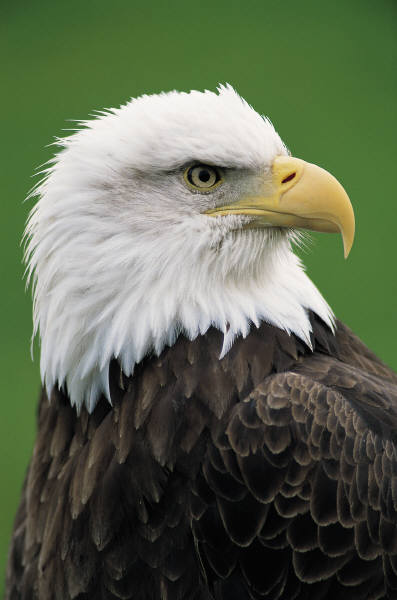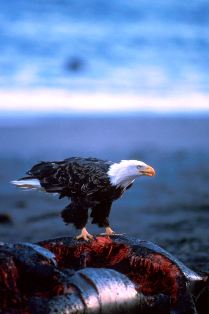
Nutrition:
The diets of a bald eagle can be described by only one word: diverse. Analyzing eagle diets are done by observing and recording the food remains found in nests or feeding perches, and by dissecting food pellets that contain the undigested portions of different food items. From this gathered information, one can construct a fairly accurate estimate of food proportions. The book The Bald Eagle by Stalmaster has these ratios worked out to be:
- Fish - 56%
- Birds - 28%
- Mammals - 14%
- Other - 2%
These numbers of course vary from bird to bird and location to location, but it gives you a reasonable idea of what the Bald Eagle's diet consists of.
One of the reasons Ben Franklin objected to the Bald Eagle being the United States' national bird was that they were too lazy to hunt on their own and would rather steal from more noble birds. His observation was partially accurate because stealing food does seem to be the eagle's most preferred means of gathering food. There are two forms of this thievery: the stealing from other eagles, or pirating, and the stealing from other species, or kleptoparasitism. Bald Eagles are quite adept at both these forms.
A Bald Eagles favorite target is the Osprey, a much smaller sea eagle by comparison. Observations have shown that nearly half of all foraging efforts of the osprey are in some way interfered with by a Bald Eagle. The eagle will harass the target bird until it tires or fears for its safety, which causes it to drop the fish making it an easy target for the eagle.
Osprey may feel unfairly picked on, but in fact the Bald Eagle does not limit his harassment to one species, and attacks a wide variety of species. Even Sea Otters are victims! They feed floating on their backs with food resting on their stomachs, which makes for a perfect platform for the thieving eagle.
Pirating from other bald eagles seems to be a peculiar technique, but feeding eagles have been observed dropping their current meal to go and attempt to steal from others. The reasoning for this is no understood. It has been suggested that stealing food may lie in the evolutionary makeup of the bald eagle. For example, when food shortages were low, those who stole their food thrived, but those who did not perished - Survival of the fittest, or in this case, perhaps survival of the sneaky.
Lastly, the least preferred technique to foraging. Hunting is used the least because it requires to most energy, but eagles have found ways to minimize the energy requirement. Most of the hunting strategies eagles have perfected rely on some element of surprise, usually swooping down from a perch and snagging the unsuspecting prey with its talons, often times pinning it to the ground until it has suffocated or bled to death. Animal remains left in the nests of eagles suggest that the bald eagle targets injured or sickly animals. Targeting the weak reduces the risk of a struggle and greatly increases the chance of a successful hunt.
Bald Eagles have even been known to hunt in pairs where one eagle attempts to flush and herd smaller animals into a specific location where it is more vulnerable to the other awaiting eagle.

